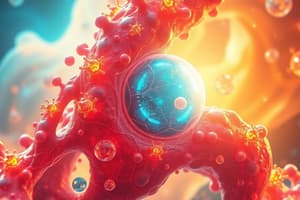Podcast
Questions and Answers
What initiates the power stroke in myosin motor proteins?
What initiates the power stroke in myosin motor proteins?
- Binding of ADP to myosin
- Release of inorganic phosphate (correct)
- Conformational shift in actin
- Hydrolysis of ATP
What happens when ADP is released from the myosin head?
What happens when ADP is released from the myosin head?
- Myosin head detaches from the filament
- Myosin changes to a more extended conformation
- Myosin remains tightly bound to actin (correct)
- Myosin binds to actin more loosely
Which process causes myosin to move further along the filament?
Which process causes myosin to move further along the filament?
- Release of inorganic phosphate (correct)
- Conformational change of actin
- Binding of ATP
- Release of ADP
What is the primary role of ATP in muscle contraction?
What is the primary role of ATP in muscle contraction?
What concept was proposed in the groundbreaking papers by Huxley and others in 1954?
What concept was proposed in the groundbreaking papers by Huxley and others in 1954?
What is the primary function of calcium ions in muscle contraction?
What is the primary function of calcium ions in muscle contraction?
Which type of signal is measured by an ECG?
Which type of signal is measured by an ECG?
What occurs when ATP binds to the myosin head during muscle contraction?
What occurs when ATP binds to the myosin head during muscle contraction?
Which instrument is used to measure electrical signals from muscles?
Which instrument is used to measure electrical signals from muscles?
What is the role of myofibrils in muscle cells?
What is the role of myofibrils in muscle cells?
Which type of biological signals is measured by a CT scan?
Which type of biological signals is measured by a CT scan?
What causes the 'rigor conformation' in the myosin head?
What causes the 'rigor conformation' in the myosin head?
Which type of channels allows calcium to enter muscle cells?
Which type of channels allows calcium to enter muscle cells?
Study Notes
Introduction to Biosensing and Bioinstrumentation (BSBI)
- BSBI integrates biological sciences with engineering to develop devices for monitoring and analysis.
- Applications include medical diagnostics, environmental monitoring, and food safety.
Electrical Signals in Biology
- Key areas: neurons, muscles, cardiac cells, eyes, skin, and gut.
- Measurement instruments: EEG (brain), EMG (muscles), ECG (heart), EOG (eyes), ERG (retina), EDA (skin response), EGG (gastrointestinal).
Mechanical Signals in Biology
- Focus on vital organs: lungs, heart, and blood vessels.
- Various instruments exist to measure pressure and volume changes.
Chemical Signals in Biology
- Analyzed in bodily fluids: blood, urine, saliva, mucus, tissues, and sweat.
- Instruments include spectrophotometers and chemical analyzers for detecting specific biomarkers.
Thermal Signals in Biology
- Relevant for body temperature regulation and monitoring.
- Sensors include thermocouples and thermistors for accurate temperature readings.
Common Medical Diagnostic Instruments
- CT Scan provides detailed cross-sectional images.
- MRI uses magnetic fields for soft tissue imaging.
- XRD analyzes crystal structures.
- Raman Spectroscopy identifies molecular composition.
Wearable Electronics
- Innovations in artificial synapses and memristors highlight advances in smart medical technologies.
- Development of devices for real-time health monitoring.
Electric Signals in the Heart
- Calcium (Ca2+) and potassium (K+) ion channels control electrical impulses.
- Leaky ion channels contribute to membrane potentials, vital for heartbeat regulation.
Muscle Force Generation
- Muscle cells composed of myofibrils utilize actin and myosin for contraction.
- Calcium ions play a pivotal role in initiating contractions through interaction with regulatory proteins.
Role of ATP in Muscle Contraction
- ATP binding releases myosin from actin, allowing for cycle continuation.
- Hydrolysis of ATP leads to myosin conformational changes, facilitating the 'power stroke'.
- Myosin reverts to original conformation post-stroke, releasing ADP while remaining bound to actin.
Sliding Filament Theory
- Proposed by Huxley and Niedergerke in 1954, it describes muscle contraction mechanisms.
- High-resolution microscopy revealed changes in sarcomeres during muscle shortening.
- Interaction between myosin and actin filaments generates contractile force, confirming the sliding filament model.
Studying That Suits You
Use AI to generate personalized quizzes and flashcards to suit your learning preferences.
Related Documents
Description
This quiz explores the fundamentals of biosensing and bioinstrumentation, covering key applications, electrical signals in various biological systems, and the instruments used to measure these signals. You'll learn about the significance of BSBI in health and science, and the technological advancements that enable the monitoring of biological signals. Ideal for students and professionals interested in the field of bioengineering.


